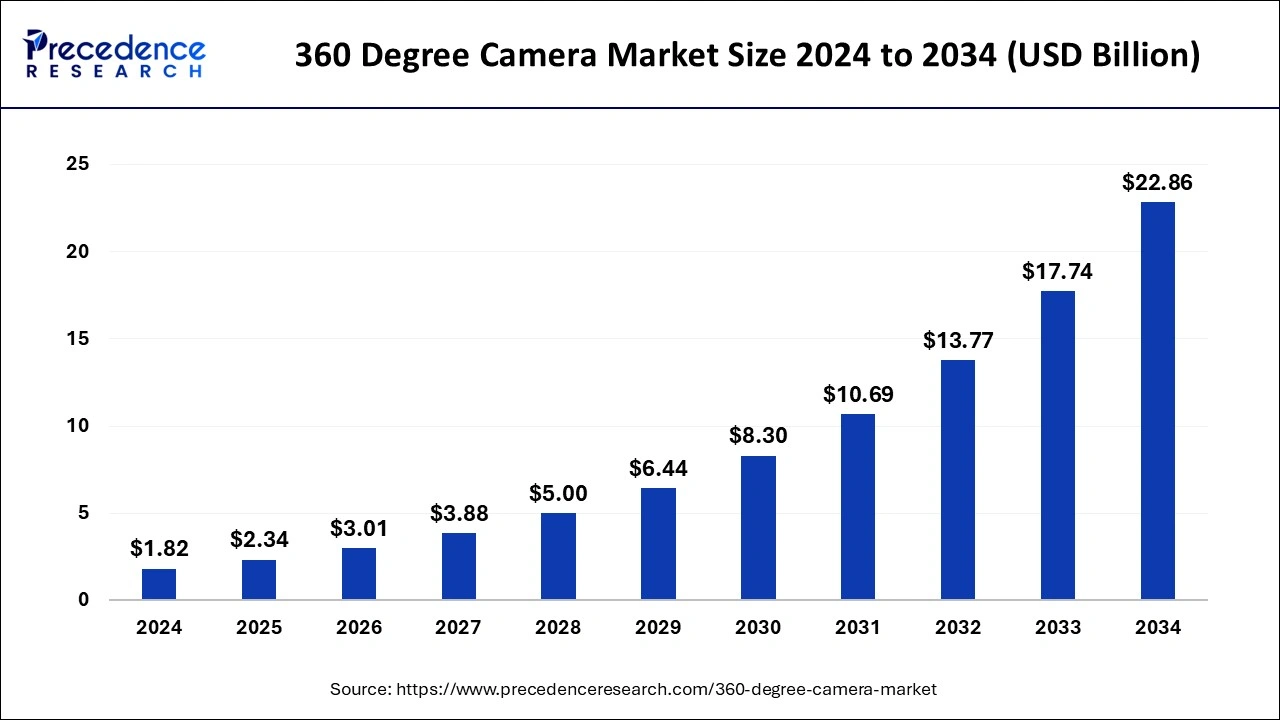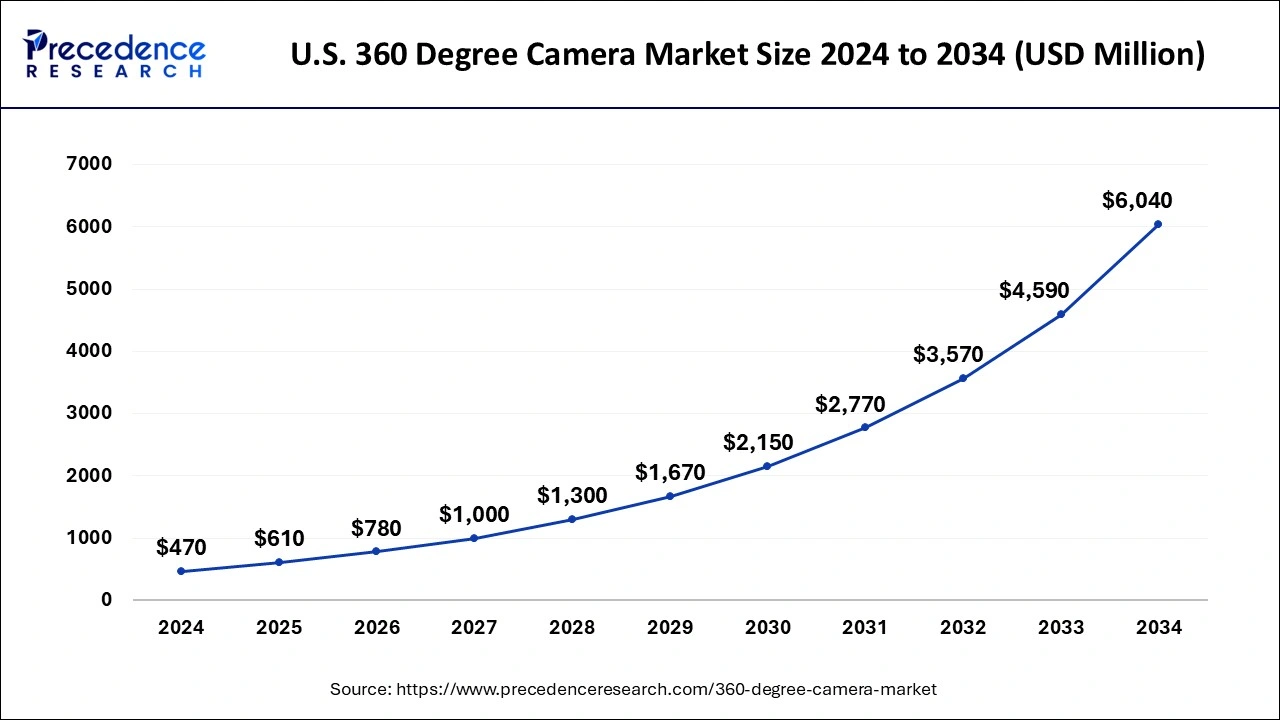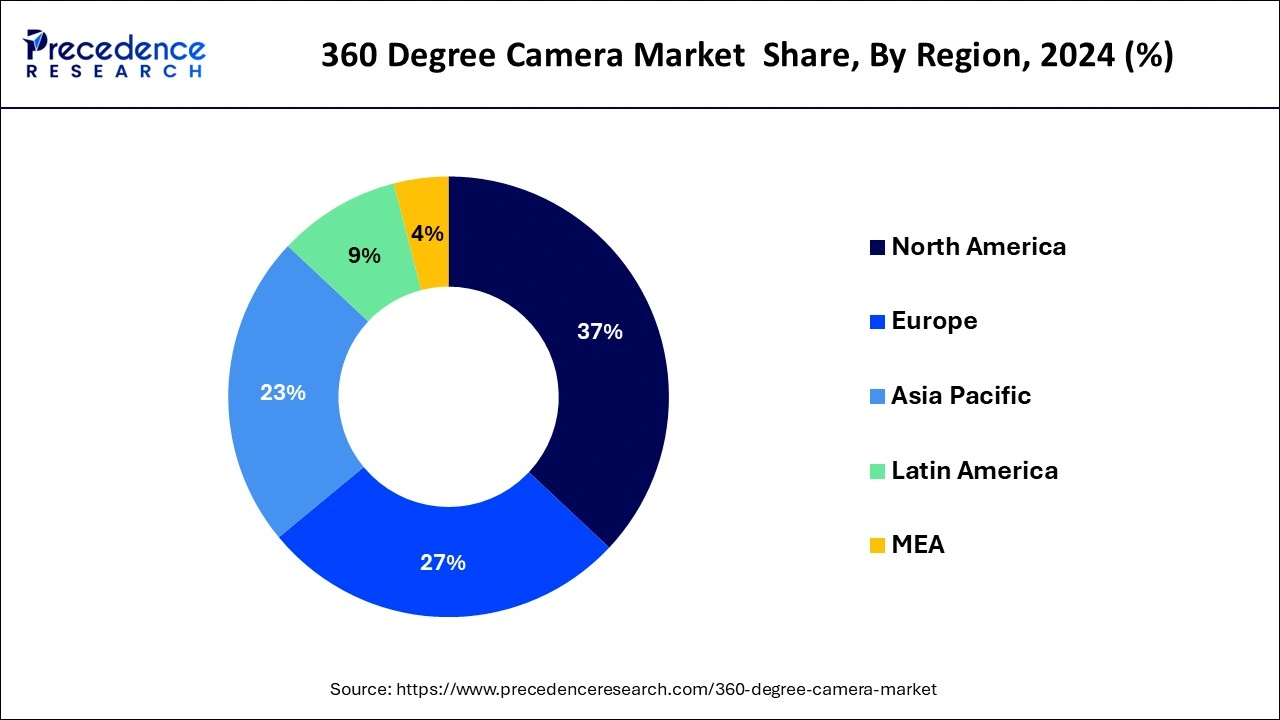What is 360 Degree Camera MarketSize?
The global 360 degree camera market size is calculated at USD 2.34 billion in 2025 and is predicted to reach around USD 27.21 billion by 2035, expanding at a CAGR of 27.81% from 2026 to 2035. The rising demand for 360-degree cameras across diverse fields like entertainment and media, travel and tourism, real estate, and security surveillance boosts the growth of the market.

Market Highlights
- North America dominated the global market with the largest market share of 37% in 2025.
- Asia Pacific is projected to expand at the notable CAGR during the forecast period.
- By connectivity type, the wired segment has held the largest market share in 2025.
- By connectivity type, the wireless segments is predicted to be the fastest-growing segment during the forecast period.
- By resolution, the high definition (HD) segment captured the biggest market share in 2025.
- By resolution, the ultra-high definition (UHD) segments is estimated to be the fastest-growing segment during the forecast period.
- By vertical, the consumer segment contributed the highest market share in 2025.
- By vertical, the media and entertainment segment is expected to grow at a significant CAGR from 2026 to 2035
Impact of AI on the 360 Degree Camera Market
Artificial intelligence plays a crucial role in 360-degree camera mapping by analyzing a large dataset collected by these cameras in a short period of time. Such analysis is important in urgent scenarios. 360-degree cameras capture panoramic visuals with a full view of the environment. However, AI algorithms help to transcribe detailed panoramic images. It also helps in enhancing images and videos captured by these cameras. With the help of AI, these cameras can scan objects in real time.
Market Overview
A 360 degree camera has a field of vision that encompasses almost the entire sphere or at least a full circle in the horizontal plane. In applications where vast visual field coverage is required, such as panoramic photography and robotics, 360-degree cameras are commonly employed in robotics for visual simultaneous localization and mapping and visual odometry challenges. Better results for optical flow and feature selection matching can be achieved due to its capacity to record a 360-degree image.
There are several 360 degree camera implementations available, including cameras with more than 30 lenses and two opposing fisheye lens combinations. There are a variety of 360-degree cameras available in the market, including Z-CAM, MadV, Red Digital Cinema, Ricoh, FXG, Panono, Trisio, Vuze, Insta360, Gear360, GoPro, and Kandao.
The 360-degree cameras are also available as standalone and single cameras with many lenses that assist in recording and automatically merging the content captured by the device. The greatest thing about utilizing 360-degree cameras is that they are simple to use compared to other cameras and are inexpensive.
360 Degree Camera Market Growth Factors
- High adoption of 360-degree cameras in the media & entertainment industry for creating immersive content boosts the growth of the market.
- The growing popularity of real-time streaming further boosts the demand for 360-degree cameras. They offer a real-time view with wide angles, enhancing consumer engagement.
- The rising trend of photography can have a positive impact on the market.
- The growing deployment of 360-degree cameras in autonomous vehicles is likely to boost market growth.
- The rising use of 360-degree cameras in surveillance and security applications further fuels the market's growth.
Market Scope
| Report Coverage | Details |
| Market Size in 2025 | USD 2.34 Billion |
| Market Size in 2026 | USD 3.01 Billion |
| Market Size in 2035 | USD 27.21 Billion |
| Growth Rate | CAGR of 27.81% from 2026 to 2035 |
| Largest Market | North America |
| Fastest Growing Market | Asia Pacific |
| Base Year | 2025 |
| Forecast Period | 2026 to 2035 |
| Segments Covered | Connectivity Type, Resolution, Vertical, Region |
| Regions Covered | North America, Europe, Asia-Pacific, Latin America, and Middle East & Africa |
Market Dynamics
Drivers
Platforms such as Facebook, Instagram, and YouTube have fully embraced 360-degree content, creating an engaging environment where users are encouraged to capture and share immersive experiences. These platforms are transforming the landscape of digital interaction by allowing users to experience content in a more interactive and lifelike manner. To facilitate this shift, 360-degree cameras have become essential tools for producing high-quality immersive content, particularly in the realms of virtual reality (VR) and augmented reality (AR), thereby boosting market growth. The increasing popularity of virtual and augmented reality content and the increasing usage of virtual reality headsets are propelling the global 360 degree camera market growth.
Restraints
Despite the growing interest in 360-degree cameras, several factors limit their widespread adoption. One of the major challenges the market faces is the high costs associated with 360-degree cameras, restricting their accessibility to a broader consumer base. This financial limitation can deter potential buyers and content creators from investing in them. Additionally, technical challenges associated with seamlessly stitching together images from multiple cameras can be a significant concern. Achieving a cohesive and distortion-free 360-degree image requires advanced skills and software, and failures in this process can result in visual artifacts that detract from the immersive experience.
Opportunities
There are promising advancements on the horizon that could revolutionize the 360 degree camera market. Rapid developments in sensor technology and image processing algorithms enable the creation of high-resolution images and more realistic content. These developments make these cameras more appealing to consumers and creators alike. Furthermore, integrating artificial intelligence into 360-degree cameras unlocks a range of advanced features, including object recognition. These capabilities can simplify content creation and improve user experience.
Segment Insights
Connectivity Type Insights
Based on the connectivity type, the wired segment dominated the global 360 degree camera market in 2025, in terms of revenue. Wired cameras are connected to a power source and the internet connection by cable. This type of cameras is widely used in photo studios.
On the other hand, the wireless segment is estimated to be the most opportunistic segment during the forecast period. The wireless 360 degree cameras are widely used for commercial and residential purposes. This type of cameras is also used for the home security.
Resolution Insights
Based on the resolution, the high definition (HD) segment dominated the market in 2025. Due to high definition (HD) 360 degree camera's increased clarity, the image on screen can be less blurry. Other advantages of high definition (HD) include better motion and brighter and more natural colors.
On the other hand, the ultra-high definition (UHD) is estimated to be the most opportunistic segment during the forecast period. The ultra-high definition (UHD) 360 degree camera are little expensive than high definition (HD) 360 degree cameras. The photos and videos taken by this camera is of high quality.
Vertical Insights
Based on the vertical, the consumer segment accounted largest revenue share in 2025. The use of 360 degree cameras is growing in a variety of applications including sports, photography, events, and festivals, indicating that the 360 degree camera market has capacity to grow.
On the other hand, the media and entertainment segment is estimated to be the most opportunistic segment during the forecast period. The multiple cameras are used in the 360 degree camera setups, resulting in exceptional 360 degree images. These setups are simple to use and incredibly durable, making them ideal for a variety of shooting scenarios.
Regional Insights
U.S. 360 Degree Camera Market Size and Growth 2026 to 2035
The U.S. 360 degree camera market size is exhibited at USD 610 million in 2025 and is projected to be worth around USD 7,203 million by 2035, growing at a CAGR of 28% from 2026 to 2035

Based on the region, the North America dominated the market with highest market share in 2022. The tendency of customers to adopt technologically advanced products, as well as the presence of large number of market players producing solo cameras and setups, are driving the market growth in North America.
United States
The United States maintained its dominance in the 360 Degree Camera Market due to factors such as the early adoption of the technology and a sudden surge in social media content creation in recent years. Moreover, the major brands in the United States have seen in focused on improvement of the software, content platform, and user interface in the past few years. Also, the presence of the advanced film-making and content creation industry has supported industry growth in recent years.

On the other hand, the Asia-Pacific is estimated to be the most opportunistic segment during the forecast period. The growing demand for 360 degree cameras in virtual reality games will fuel the growth of the 360 degree camera market in Asia-Pacific region.
China
China is expected to emerge as a prominent country for the market in the coming years, owing to the increased focus on mass products instead of niche tools. Furthermore, the manufacturers in China have heavily integrated the latest technology in the production of cameras, such as AI processing and smartphone linking. Moreover, the heavier domestic usage is likely to create lucrative opportunities in the coming years.
Value Chain Analysis
- Distribution to Industrial Users
The 360-degree camera market is increasingly shifting from consumer leisure toward high-value industrial and professional applications. Distribution to industrial users is primarily managed through direct sales/B2B channels, which provide the specialized hardware-software integration and technical support required for enterprise deployments.
Key Players: Denso, Samsung, Sony, and Insta360 - Chemical Synthesis and Processing
The chemical synthesis and processing aspect of the 360-degree camera market focuses on advanced material science to improve light transmission, sensor durability, and extreme-environment performance for industrial users.
Key Players: ZEISS and Mitsui Chemicals - Regulatory Compliance and Safety Monitoring
The 360-degree camera market is governed by stringent data privacy and cybersecurity mandates. In India, the STQC/ER certification (effective April 2025) is now mandatory for surveillance hardware to ensure "security-by-design." Globally, GDPR and updated CCPA rules drive the adoption of on-device AI for real-time face and license plate blurring.
Key Agencies: OSHA (U.S.) and EU-OSHA
360 Degree Camera Market Companies
- LG Electronics
- Samsung Electronics
- PONONO (Professional 360 GmbH)
- Digital Domain Productions
- YI Technology
- Immervision
- Nikon
- Xiaomi
- GoPro
- 360fly
Recent Development
- In November 2023, Ricoh entered into a strategic partnership with Cupix, the frontrunner in AI-powered 4D as-built platforms. Through this collaboration, Ricoh's latest 360-degree camera, the RICOH THETA X, is now fully integrated and supported within CupixWorks and CupixVista, offering unparalleled 3D spatial digital twin imaging solutions.
Segments Covered in the Report
By Connectivity Type
- Wired
- Wireless
By Resolution
- High Definition (HD)
- Ultra-high Definition (UHD)
By Camera Type
- Single
- Professional
By Vertical
- Media & Entertainment
- Consumer
- Military & Defense
- Travel & Tourism
- Automotive
- Commercial
- Healthcare
- Others
By Region
- North America
- Europe
- Asia-Pacific
- Latin America
- Middle East & Africa



